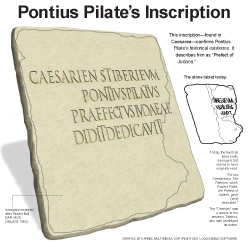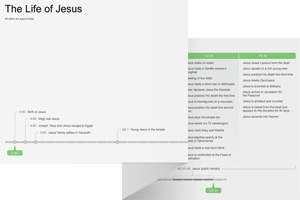13:1–5 Continuing the theme of judgment from ch. 12, Jesus uses two calamities that befell certain Jews to illustrate the fate that awaits those who do not repent. This material is unique to Luke’s Gospel. |
13:1 at the same time Refers to the time of Jesus’ discourse in ch. 12.
whose blood Pilate had mixed with their sacrifices Refers to the killing of Galilean pilgrims as they were offering sacrifices in Jerusalem. Pontius Pilate, the Roman governor of Judaea from ad 26 to 36, apparently ordered their deaths. No other details are known, as these verses give the only account of this incident.
the Roman governor of Judaea from ad 26 to 36, apparently ordered their deaths. No other details are known, as these verses give the only account of this incident.
 Political Leaders in the New Testament Table
Political Leaders in the New Testament Table
13:2 these Galileans were sinners worse Jesus’ rhetorical question reflects the belief—common among first-century Jews—that physical affliction was caused by sin (compare John 9:2). Jesus counters this assumption in the next verse.
13:3 No Jesus asserts that the Galileans’ deaths were not the result of excessive sin.
unless you repent you will all perish Jesus uses this incident (and that mentioned in Luke 13:4) to illustrate the necessity of repentance.
13:4 the tower in Siloam Siloam was located in the southeastern corner of Jerusalem, and the tower may have been an original structure from the city of David, as described by the first-century ad Jewish historian Josephus (Josephus, Jewish War 5:145). Like the report in v. 1, this is the only account of this incident.
do you think that they were sinners worse See v. 2 and note.
13:5 unless you repent, you will all perish See v. 3 and note.
13:6–9 This parable is found only in Luke, but it resembles Jesus’ rebuke of the fig tree in the other Synoptic Gospels (Matt 21:18–19; Mark 11:12–14). The primary point of the parable, expressed in Luke 13:8–9, continues the theme of judgment. |
 Parables of Jesus Table
Parables of Jesus Table
13:8 leave it alone this year also Suggests a period of grace. The gardener advises the vineyard owner to give the fig tree more time; perhaps it can be nurtured, so that it will bear fruit.
13:10–17 In another passage unique to Luke, Jesus again faces criticism after He performs a healing on the Sabbath (compare 6:6–11). |
13:11 a spirit that had disabled her The woman’s distorted posture appears to be the result of demonic activity, as opposed to a defect suffered from birth.
13:14 come and be healed on them The people were coming to Jesus for healing without regard for the day. Jesus was not bothered by this; indeed, His actions encouraged it. The religious leaders saw His healings as a violation of God’s command to honor the Sabbath by refraining from work.
 Miracles of Jesus Table
Miracles of Jesus Table
13:15 untie his ox or his donkey Jesus calls attention to the religious leaders’ willingness to make exceptions to the law to care for animals but not to care for God’s people.
13:16 a daughter of Abraham Identifies the woman as a Jew.
whom Satan bound eighteen long years See v. 11.
13:18–21 Jesus tells two parables that illustrate the tremendous growth of God’s kingdom from small beginnings. Parallel accounts appear in the other Synoptic Gospels (Matt 13:31–33; Mark 4:30–32). |
Parable of the Mustard Seed | ||
13:19 a mustard seed A tiny seed that grows into a 10-foot-high shrub.
13:21 yeast Normally, yeast or leaven has negative connotations in Jewish literature, symbolizing impurity (compare 12:1). Here, Jesus uses the metaphor in a positive sense.
13:22–30 Jesus elaborates on the nature of the salvation He offers. |
13:22 toward Jerusalem Luke reiterates that Jesus is on His way to Jerusalem, the site of His eventual suffering and death. Jesus began this journey in 9:51.
13:23 only a few The question concerns how many will be saved. Jesus does not answer directly, but indicates that many people who seek salvation will not find it (v. 24).
13:24 the narrow door Depicts a single, small entrance.
13:25 Lord, open the door for us Matthew uses similar language in the parable of the ten virgins, five of whom are shut out of the wedding celebration (Matt 25:10–12).
13:27 go away from me, all you evildoers Reflects the wording of Psa 6:8; compare Matt 7:23.
13:28 weeping and gnashing of teeth See Matt 8:12 and note.
but yourselves thrown outside Not everyone who expects to be saved will be (Luke 13:25–28).
13:29 east and west, and from north and south In a statement that would have shocked His hearers, Jesus alludes to non-Jews coming from all over the world to join the banquet in God’s kingdom (compare Matt 8:11).
13:30 some are last who will be first Compare Matt 19:30 and note.
13:31–35 While on His way to Jerusalem, Jesus offers a lament for the city. |
13:31 Pharisees came up and said to him Despite largely negative portrayals of the Pharisees, not all of them were hostile toward Jesus (see Luke 7:36 and note).
Go out and depart from here Galilee and Perea, the regions where Jesus has been traveling and ministering, were under the jurisdiction of Herod Antipas (see 3:1 and note).
13:32 Go and tell A rhetorical reply, not an instruction to report back to Herod.
fox An unflattering metaphor that alludes to Herod’s cunning.
I will complete my work Jesus speaks figuratively about His ministry, death, and resurrection—that He will accomplish His purposes and work (compare 9:22; 18:33).
13:33 prophet to perish outside Jerusalem In this not-so-subtle indictment of the Jewish capital and its religious establishment, Jesus insinuates that prophets are killed only inside the holy city.
13:34 Jerusalem, Jerusalem Compare Matt 23:37–39.
kills the prophets See Luke 11:47–51.
under her wings A common metaphor in the ot used to show God’s protection (e.g., Pss 17:8; 57:1; 91:4; see note on Ruth 2:12).
13:35 your house has been left to you Jesus might be referring to the temple, Jerusalem itself, or the people of Jerusalem.
one who comes in the name of the Lord Jesus quotes from Psa 118:26, probably referring to His second coming. This same verse is quoted by Jesus’ followers as He enters Jerusalem (Luke 19:38).

|
About Faithlife Study BibleFaithlife Study Bible (FSB) is your guide to the ancient world of the Old and New Testaments, with study notes and articles that draw from a wide range of academic research. FSB helps you learn how to think about interpretation methods and issues so that you can gain a deeper understanding of the text. |
| Copyright |
Copyright 2012 Logos Bible Software. |
| Support Info | fsb |
 Loading…
Loading…


